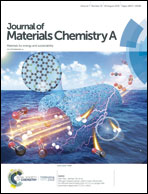Hierarchical multicarbonyl polyimide architectures as promising anode active materials for high-performance lithium/sodium ion batteries†
Abstract
A novel hierarchical multicarbonyl polyimide derivative was synthesized by facile condensation polymerization of 3,3′,4,4′-diphenylketotetraanhydride and 2,6-diaminoanthraquinone, which benefits from various carbonyl groups and benzene rings in each monomer. The designed chemical composition and careful regulation of polymerization conditions endow it with an unprecedented superstructure with spherulite-like architectures constructed by highly compact arrangement of packed 2D nanosheets, which is favorable to trigger interfacial energy storage and contribute to a large storage capacity. When explored as an anode material for lithium-ion batteries, the polyimide derivative could deliver a reversible capacity of 1343.8 mA h g−1 at 100 mA g−1, a good rate capability of 208.9 mA h g−1 at 1.5 A g−1 and an excellent cycling performance of 665.1 mA h g−1 at 250 mA g−1 after 50 cycles. Aided by theoretical calculations and probing of electrochemical behaviors, a rational prediction for the complex lithium-ion storage mechanism is proposed. Furthermore, the obtained polymeric electrode also demonstrates good sodium-storage activity with a high capacity of 275.8 mA h g−1 at 25 mA g−1 and a good cycling stability of 130 mA h g−1 at 50 mA g−1 for 100 cycles, demonstrating its broader applications as appealing anode materials for next-generation high-energy batteries.



 Please wait while we load your content...
Please wait while we load your content...